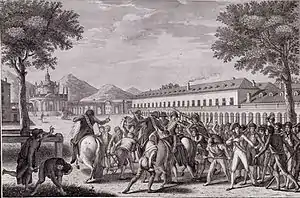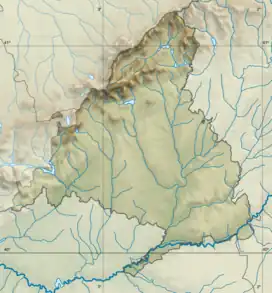Tumult of Aranjuez
The Tumult of Aranjuez (Spanish: Motín de Aranjuez), also known as the Mutiny of Aranjuez, was an uprising led against King Charles IV that took place in the town of Aranjuez, Spain, on 17–19 March 1808. The event, which is celebrated annually in the first week of September, commemorates the fall of the monarch and the subsequent accession of his son Ferdinand VII.[1] It is celebrated in September rather than in March as the revived celebrations in Aranjuez that began in 1988 were added on top of pre-existing September festivals.[2]
| Mutiny of Aranjuez | |||||||
|---|---|---|---|---|---|---|---|
| Part of the prelude to the Peninsular War | |||||||
 Fall and Imprisonment of the Prince of Peace, Manuel Godoy | |||||||
| |||||||
| Belligerents | |||||||
|
|
| ||||||
| Commanders and leaders | |||||||
|
Manuel de Godoy | |||||||
 Location within Community of Madrid  Tumult of Aranjuez (Spain) | |||||||
The revolt was instigated by disgruntled citizens and by Ferdinand's supporters.[3]
Causes of the Tumult
Before the mutiny, Charles IV's valido, or prime minister, Manuel de Godoy, a former member of the Royal Guard, had become unpopular among both the nobles and the Spanish people.
The nobility resented how Godoy had attained power even though he was born in poverty and obscurity. Most notable among them was the King's own son Ferdinand, who had led the El Escorial Conspiracy a few months earlier. The people were upset about Godoy's ambitious nature, his flirting with many women of the court and his willingness to have Catholic Spain make treaties with atheist Revolutionary France against Christian (though Anglican) Great Britain.
Another important factor was the economic crisis affecting the country, which was heightened after Spain lost its navy in the Battle of Trafalgar in 1805. This had impaired trade with the United States, causing food shortages and affecting industrial production.
In addition, under the terms of the Treaty of Fontainebleau, the King and Godoy had allowed French Emperor Napoleon's troops to cross Spain to attack Portugal. This move was extremely unpopular with the Spanish people, who saw the entry as a humiliating invasion, which it soon became. French troops rapidly occupied the important cities of San Sebastián, Pamplona, and Barcelona, fuelling Spanish resentment towards Godoy.
Mutiny
The uprising took place on 17 March 1808 in Aranjuez, about 48 kilometres (30 mi) south of Madrid, where the royal family and the government were staying while on their way south, anticipating a French invasion from the north. Soldiers, peasants, and members of the general public assaulted Godoy's quarters and captured him. The mutineers made King Charles dismiss Godoy, and, two days later, the court forced the King himself to abdicate in favor of his son and rival, who became King Ferdinand VII.[4]
Aftermath
In 1808 Napoleon, under the false pretense of resolving the conflict, invited both Charles IV and Ferdinand VII to Bayonne, France. Both were afraid of the French ruler's power and thought it appropriate to accept the invitation. However, once in Bayonne, Napoleon forced them both to renounce the throne and grant it to himself. The Emperor then named his brother Joseph Bonaparte king of Spain. This episode is known as the Abdications of Bayonne, or Abdicaciones de Bayona in Spanish.
See also
References
- "Las fiestas del Motín de Aranjuez" (in Spanish). AranNet.com. 2012. Retrieved 17 April 2013.
- VV.AA. (2012). 50 años de ferias y fiestas de Aranjuez. Ediciones Marañón. ISBN 978-84-938571-7-2.
- (in Spanish) Barrios, Feliciano; Escudero, José Antonio (2009). España, 1808: el gobierno de la monarquía. Real Academia de la Historia. pp. 23–. ISBN 978-84-96849-51-8.
- Stanley G. Payne, History of Spain of Portugal, Vol 2, University of Wisconsin Press., 1973, ISBN 978-0-299-06284-2, page 420
External links
 Media related to Mutiny of Aranjuez at Wikimedia Commons
Media related to Mutiny of Aranjuez at Wikimedia Commons